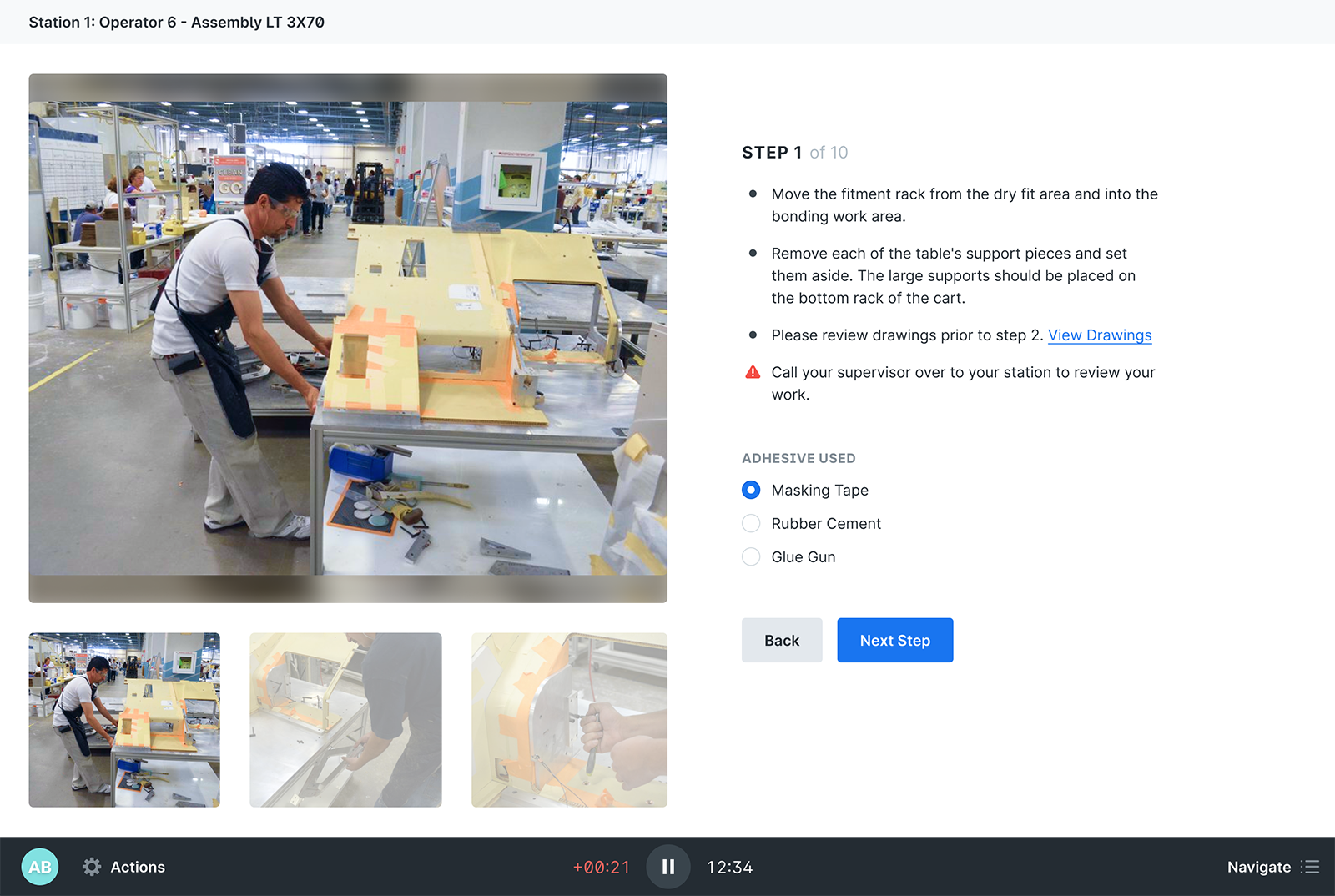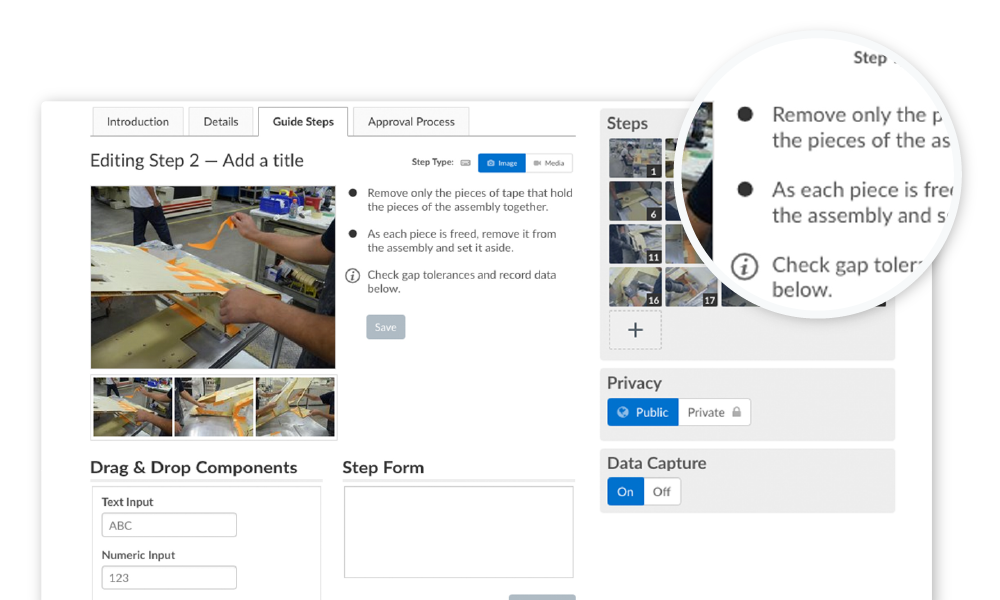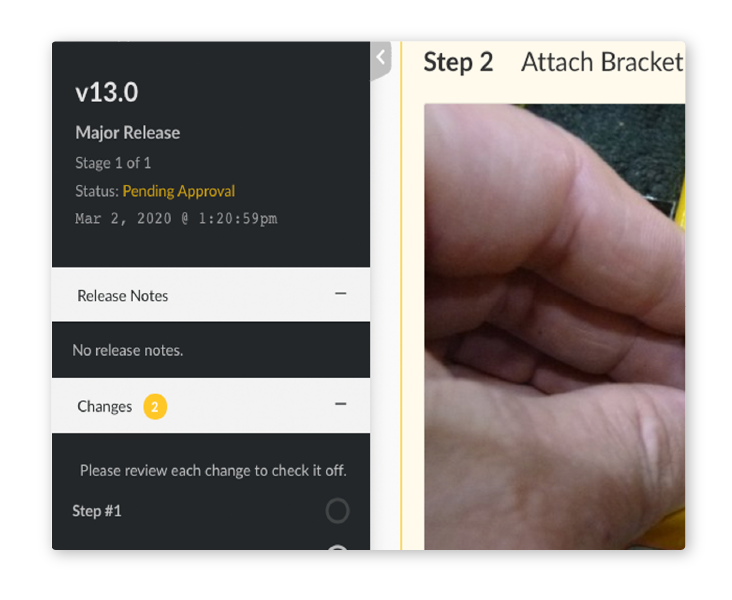
Work Instructions
10 min read
The Cost of Bad Work Instructions

Bad work instructions are the norm.
Documentation is often created to check a box for audit or compliance purposes.
But once completed, those work instructions get trapped in paper binders, collecting dust on a shelf at the facility. Or buried in complex file systems that are intimidating to navigate.
What could that cost your organization?
According to our research, 78% of manufacturers report using outdated or ineffective work instructions. And the downstream effects of this communication and training issue ripple throughout the entire company.
Based on a decade of hands-on experience working with the largest manufacturers in the world, we’ve compartmentalized these costs into four categories:
- Increased Down Time
- Lost Productivity
- Higher Turnover
- Longer Time To Competency
For each one, we’ll offer practical advice to help you create, distribute and improve your work instructions. By the time you’re done reading, good instructions will become the norm on your floor.
Cost #1: Increased Downtime
The main goal of the management of a production site is to produce high-quality products with the lowest possible costs.
A key tenant of doing so is keeping downtime as low as possible. Unplanned downtime means you're not producing products. Forbes recently published the numbers on unplanned downtime in manufacturing, and how it’s one of the largest causes of lost productivity, causing delays, unhappy customers and lost revenue. The problem costs industrial manufacturers an estimated $50 billion each year, according to recent studies.
Consider the Production Supervisor working in the food and beverage industry. With aggressive production targets, she can’t afford to waste time doing changeovers and turnovers that eat into output goals.
If she’s having a repetitive action causing downtime, she might perform a root cause analysis. And more than likely, she’ll realize that there are different causes, all coming from different people. This means their operators don’t have one true standard that they are allowing.
One of our clients recently discovered a brand new operator was following a step from a paper work instruction with no visuals, and he put oil on the completely wrong side of the machine. He made an honest mistake, but that’s what happens when you don’t have a unified, visually useful, best way to perform a routine task.
Want to avoid incurring this downtime cost? Here’s a pro tip to make bad work instructions good:
Front-load or highlight useful details. This ensures that the most essential information is communicated.

Learn more about reducing downtime with Video in Work Instructions.
Cost #2: Lost Productivity
Standardization is the foundation for improvement. Regardless of what your team produces, there is a need for standardized work instructions for consistency and repeatability in your manufacturing process.
And chances are, your existing work instructions are text-heavy, paragraph-driven documents that are notoriously tough to get through.
This may only seem like a communication issue, but it’s also a productivity issue.
Using bad work instructions means the training operators receive isn’t consistent or controlled. Oftentimes, your best workers will be pulled to the frontline to provide supplemental training to make up for impossible-to-read guides. That cuts into valuable production time.
Additionally, bad work instructions mean procedures won’t be performed properly the first time. Leading to a loss of materials, and time, and potentially falling short of production goals.
Thammasat University, a public research institution in Thailand, published a fascinating paper on technical writing for engineers. The researchers at their renowned Language Institute reported:
“Having good work instructions is the key to minimizing variation, allowing manufacturers to improve product and process quality. With accurate, concise, and unambiguous technical content; an easy-to-follow presentation; and accurate use of grammar, spelling, and punctuation, manufacturers can eliminate confusion and ambiguity during specific assembly operations.”
This research shows us that the further upstream work instruction problems can be corrected, the lower the production cost. Nipping that communication issue in the bud can pay dividends down the road.
Want to avoid incurring this productivity cost? Here’s a pro tip to make bad work instructions good:
Choose a format that supports bullets or numbers to break up the text. This makes it easier for employees to comprehend.
Learn more about regaining productivity with Standardization for Authors.
Cost #3: Higher Turnover
Dozuki recently came across a one-star review written by a former Quality Control Technician at an electronics manufacturer. The disgruntled employee wrote a comment that caught our eye:
“I can’t believe I followed bad work instructions from 1982!”
This sentiment is shockingly common in manufacturing.
Frontline workers often complain about not having updated records of how to fix production problems, or why they might have occurred in the first place. This makes their daily employee experience less satisfying and more stressful, which disengages them, and contributes to high turnover.
What manufacturers must remember is:
An investment in digital work instructions is an investment in your people.
When fully leveraged, work instructions are an integral part of how you teach new skills, test for competency, and implement process improvements. When you put a moratorium on subpar work instructions and invest in your documentation, you’re investing in employee performance.
Remember, a key factor in reducing turnover is a lack of the person’s ability to see a career path or ladder, including skills development. Your ability to recruit and train the required workforce must keep pace with the growing complexity of manufacturing jobs.
Want to stop incurring this turnover cost? Here’s a pro tip to make bad work instructions good:
Teach, don’t describe. Don’t just demonstrate how a process is supposed to work. Use instructions that teach the reader as they progress through each step.

Cost #4: Longer Time To Competency
How quickly do your new operators get up to speed? What’s the gap between their day-one training and the moment the organization starts profiting from their work?
This metric of Time To Value (TTV) traditionally refers to the amount of time it takes for a new customer to receive the desired outcome through your product. From the perspective of new team member onboarding, the metric is also known as Time To Productivity or Time to Competency,
Your frontline team members are no different.
When it comes to digital work instructions, brand new employees should be empowered to comment, observe, and improve on those materials, even on their first day on the job. If they have an opportunity to immediately contribute to the standard, engagement will follow suit.
In our recent Voices of Manufacturing podcast, we discussed scaling tech with Michael Muilenburg from 3M. He dove into the topic of employee ownership, and here’s what we learned:
“Even on a relatively simple, day-one job, the operators should be thinking about troubleshooting. Troubleshooting is about diagnosing in real-time, in the heat of the battle. Put those ideas into your standard work, and you'll save a lot of money.”
Micheal told us how at 3M, even if someone works in the mailroom, they can review a standard every day. It's all digital and all captured, and that step is required for new team members to address it. This communication ritual forces the continuous improvement engine into play.
Ultimately, this leads to engaged frontline employees whose time to value is immediate and significant.
Want to avoid incurring the time-to-value cost? Here’s how to make bad work instructions good:
Make work instructions clear and easy to edit. Crowdsource knowledge updates from frontline team members to continuously unlock improvements in the process.

Learn more about building employee ownership with Versioning Control.
In summary, the cost of bad work instructions is expensive and pervasive, leading to increased downtime, lost productivity, higher turnover and longer time to value.
Don’t let a dusty binder on a shelf keep your organization from being as productive and efficient as possible. Quality matters at every point along the value stream.
Dozuki is the leading digital work instruction tool for over 500 industrial businesses across the world. Our platform is the premiere Frontline Digital Transformation (FDX) tool that modern companies are using to transform their manufacturing operations.
To learn more about how we can help your business schedule a demo.
Related Posts
View All Posts
Work Instructions
Why You Need a Custom Library of Digital Process Knowledge
5 min read
No worker operates in a vacuum. Human output potential is a function of our tools, our training, and our mental engagement. Your facility has state of the art tools, a...
Continue Reading
Work Instructions
Why Your Work Instructions Need Quality Checklists
4 min read
Quality checklists or inspections are a routine part of production. While they are a crucial part of quality management and control, checklists only catch errors, rather than...
Continue Reading
Work Instructions
Visual Instructions for Better Communication
6 min read
A technician is asked to write instructions for his company’s most frequently performed processes. Pulling out his laptop, he starts to document a procedure as he does it. He...
Continue Reading



